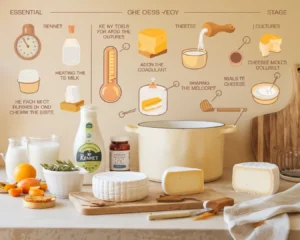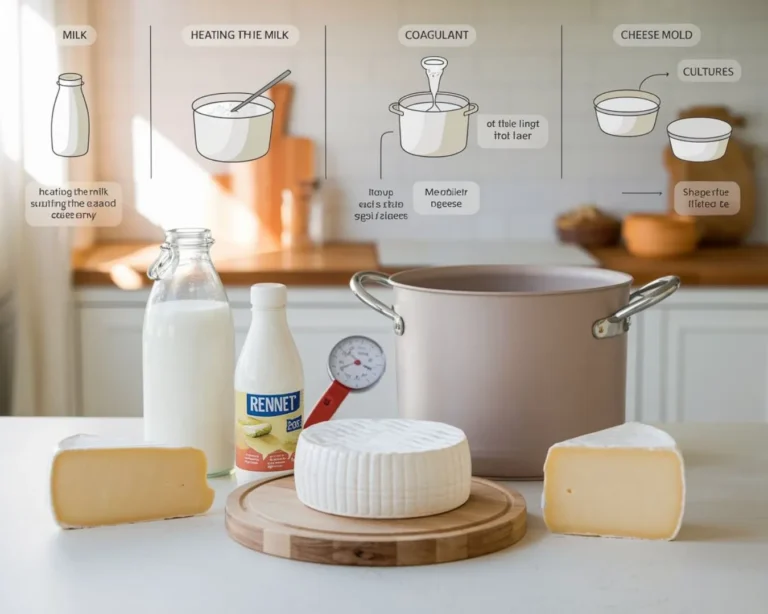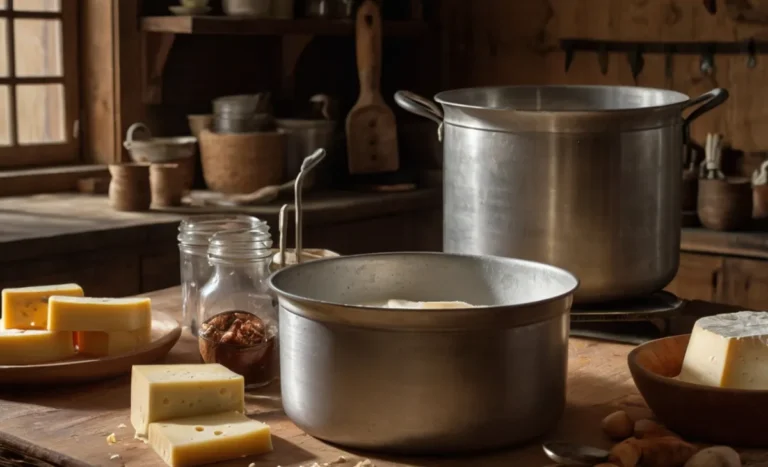How Can You Make Cheese at Home: A Step-by-Step Guide for Beginners
Introduction to Cheese Making
Cheese making is a delightful and rewarding culinary adventure. If you’ve ever wondered, “how can you make cheese,” you’re in for a treat. The process not only allows you to enjoy fresh, homemade cheese but also connects you with traditional cooking techniques. With just a few simple ingredients and tools, you can create a variety of cheeses right in your own kitchen.
To begin your cheese-making journey, it’s essential to understand the basics. Cheese is primarily made from milk, which undergoes a transformation through curdling and fermentation. By using specific cultures and enzymes, you can achieve different textures and flavors. This versatility makes cheese making an exciting hobby for anyone passionate about cooking.
As a beginner, you’ll find that cheese making is accessible and enjoyable. There are numerous recipes available, ranging from simple ricotta to more complex varieties like mozzarella and cheddar. Each type has its unique process, but the foundational techniques remain consistent. Therefore, mastering these basics will empower you to experiment with various flavors and styles.
In conclusion, cheese making is not only a fun activity but also a skill that enhances your culinary repertoire. Whether you aim to impress guests or simply enjoy a fresh cheese platter at home, the question “how can you make cheese” has a satisfying answer. Start your journey today, and savor the delicious rewards of homemade cheese!
Essential Ingredients Needed
When exploring how you can make cheese at home, understanding the essential ingredients is crucial. The primary ingredient, of course, is milk. You can use cow, goat, or sheep milk, depending on your preference and availability. Each type of milk brings unique flavors and textures to the final product, allowing for creative experimentation.
In addition to milk, you will need a coagulant, usually rennet or an acid like lemon juice or vinegar. Rennet is a natural enzyme that helps curdle the milk, while acids provide a quicker method for making softer cheeses. Selecting the right coagulant will influence the cheese’s texture and taste, so consider your recipe carefully.
Cultures are another vital ingredient in cheese making. These bacteria contribute to flavor development and the fermentation process. You can find various cheese cultures online or at specialty stores. If you’re just starting out, a basic mesophilic culture is an excellent choice for many beginner recipes.
Lastly, don’t forget about salt. Salt enhances flavor and acts as a preservative, ensuring your cheese stays fresh. The amount of salt can vary based on personal taste and the type of cheese you are making. By gathering these essential ingredients, you’ll be well on your way to successfully answering the question, “how can you make cheese” at home!
Equipment You’ll Need
When considering how you can make cheese at home, having the right equipment is essential. While the process may seem daunting, a few basic tools will make your cheese-making journey smooth and enjoyable. Investing in these items will not only improve your results but also enhance your overall experience.
First, you’ll need a large pot to heat the milk. A stainless steel pot works best because it distributes heat evenly and is easy to clean. Avoid non-stick pots, as they may not handle the high temperatures required for cheese making. Additionally, a thermometer is crucial for monitoring the milk’s temperature accurately. This ensures that your milk is heated to the right level for curdling.
Next, consider a cheese mold or a colander lined with cheesecloth. A mold helps shape the cheese as it drains, while cheesecloth allows whey to escape easily. Both options work well, so choose what suits your style. Furthermore, a slotted spoon will come in handy for stirring and transferring curds during the process.
Lastly, a few additional tools can enhance your cheese-making experience. A ladle is useful for transferring liquid, and a digital scale can help you measure ingredients precisely. By gathering these essential pieces of equipment, you’ll be well-prepared to tackle the question, “how can you make cheese” with confidence and ease!

Step-by-Step Cheese Making Process
If you’re curious about how you can make cheese at home, understanding the step-by-step process is essential. Making cheese may seem intimidating, but it can be a rewarding and fun experience. With just a few ingredients and some patience, you can create delicious cheese right in your kitchen.
First, start by heating the milk in a large pot. Gradually bring it to the appropriate temperature, usually around 190°F. Stir the milk gently to prevent scorching. Once the milk reaches the desired temperature, remove it from the heat and add your coagulant. If you’re using rennet, dissolve it in a small amount of water before adding it to the milk. Allow the mixture to sit undisturbed for about 30 minutes, during which the curds will form.
After the curds have set, cut them into small pieces with a knife. This step helps release whey and creates a firmer texture. Next, gently heat the curds while stirring to further separate them from the whey. The temperature should gradually increase to around 105°F. Once the curds have reached the right consistency, drain the whey using a colander lined with cheesecloth.
Finally, rinse the curds with cool water and add salt to enhance the flavor. At this stage, you can shape the curds into your desired form using a cheese mold or simply pack them into a container. Allow the cheese to drain for several hours or overnight, depending on the type you’re making. By following these steps, you’ll successfully answer the question, “how can you make cheese” and enjoy your homemade creation!
Common Mistakes to Avoid
When exploring how you can make cheese at home, avoiding common mistakes is crucial for success. Many beginners encounter pitfalls that can affect the final product. By being aware of these missteps, you can ensure a smoother cheese-making experience and achieve delicious results.
One frequent mistake is not using fresh ingredients. Using expired or low-quality milk can significantly impact the flavor and texture of your cheese. Always check the expiration date and opt for the best quality milk available. Additionally, ensure your cultures and coagulants are fresh and stored properly to achieve the desired fermentation.
Another common error involves incorrect temperature control. Cheese making requires precise temperatures for curdling and cooking. If the milk is too hot or too cold, it can hinder the curd formation. Invest in a reliable thermometer to monitor the temperature closely. Consistent heat will help create a firmer texture and better flavor in your cheese.
Lastly, be cautious about over-salting your cheese. While salt enhances flavor, too much can make your cheese unpalatable. Start with a small amount and adjust to taste after the cheese has aged. By avoiding these mistakes, you will confidently answer the question, “how can you make cheese” and enjoy a satisfying cheese-making journey!
Storing Your Homemade Cheese
Once you’ve successfully made cheese, the next question is how can you make cheese last longer? Proper storage is essential for maintaining freshness and flavor. Different types of cheese require specific storage methods to ensure they remain delicious and safe to eat. By following these guidelines, you can enjoy your homemade cheese for weeks or even months.
First, it’s important to choose the right wrapping materials. For soft cheeses, use wax paper or parchment paper, as these allow the cheese to breathe while preventing excess moisture. Avoid plastic wrap, as it can trap moisture and lead to spoilage. For hard cheeses, consider using cheese paper or a breathable container to maintain their texture and flavor over time.
Next, consider the ideal temperature for storing cheese. Most cheeses are best kept in the refrigerator, ideally at a temperature between 34°F and 38°F. This cool environment slows down spoilage while preserving flavor. If you have a cheese cave or a specialized cheese fridge, you can maintain optimal conditions for aging your cheeses.
Finally, always label your cheese with the date it was made and the type of cheese. This practice helps you keep track of freshness and monitor how long it has been stored. Regularly check for signs of spoilage, such as mold or off odors. By mastering these storage techniques, you will successfully answer the question, “how can you make cheese” last, allowing you to enjoy your creations for longer!
Exploring Variations and Flavors
When considering how you can make cheese at home, exploring variations and flavors can elevate your cheese-making experience. The beauty of cheese lies in its versatility, allowing you to experiment with different ingredients and techniques. By trying out various recipes, you can create unique cheeses that suit your taste preferences and impress your friends and family.
One way to add flavor to your cheese is by incorporating herbs and spices. Fresh herbs like basil, chives, or dill can infuse your cheese with delightful aromas and tastes. Additionally, spices such as garlic powder, smoked paprika, or even crushed red pepper can add a kick. Simply mix these ingredients into the curds during the cheese-making process for a personalized touch.
Another exciting option is to experiment with aging your cheese. Aging not only enhances the flavor but also changes the texture. For example, a young cheese may be soft and creamy, while an aged cheese can become firmer and more complex. Consider creating a small batch of cheese specifically for aging, allowing you to explore the differences over time.
Lastly, don’t shy away from experimenting with different types of milk. While cow’s milk is common, goat and sheep milk can yield distinct flavors and textures. Each type of milk brings its unique qualities, allowing for endless creativity in your cheese-making journey. By embracing these variations and flavors, you’ll answer the question, “how can you make cheese” with excitement and culinary creativity!
The Ultimate Guide to Cottage Cheese Recipes: From Breakfast to Dessert







